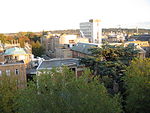Vere Harmsworth Library

The Vere Harmsworth Library is a dependent library of the Bodleian Library at the University of Oxford in the United Kingdom.The library is the university's principal research library for the study of United States history and politics and is housed on the upper floors of the Rothermere American Institute, located on South Parks Road in central Oxford, England. It is named in honour of Vere Harmsworth, 3rd Viscount Rothermere, chairman of Daily Mail and General Trust, who was prominent in raising funds and support for the construction of the building. The Vere Harmsworth Library has an extensive collection of printed primary and secondary literature, and a wide range of microfilm and online primary sources. About 80% of the library's printed collection is available as open-shelf material, with the remainder, including all works published before 1920, held underground in a climate-controlled bookstack. The library and institute were opened by US President Bill Clinton in May 2001.Since December 2019, the Vere Harmsworth Library has hosted the Radcliffe Science Library whilst it is under refurbishment.
Excerpt from the Wikipedia article Vere Harmsworth Library (License: CC BY-SA 3.0, Authors, Images).Vere Harmsworth Library
Parks Road, Oxford City Centre
Geographical coordinates (GPS) Address Nearby Places Show on map
Geographical coordinates (GPS)
| Latitude | Longitude |
|---|---|
| N 51.7576 ° | E -1.2538 ° |
Address
Science Area
Parks Road
OX1 3PD Oxford, City Centre
England, United Kingdom
Open on Google Maps










